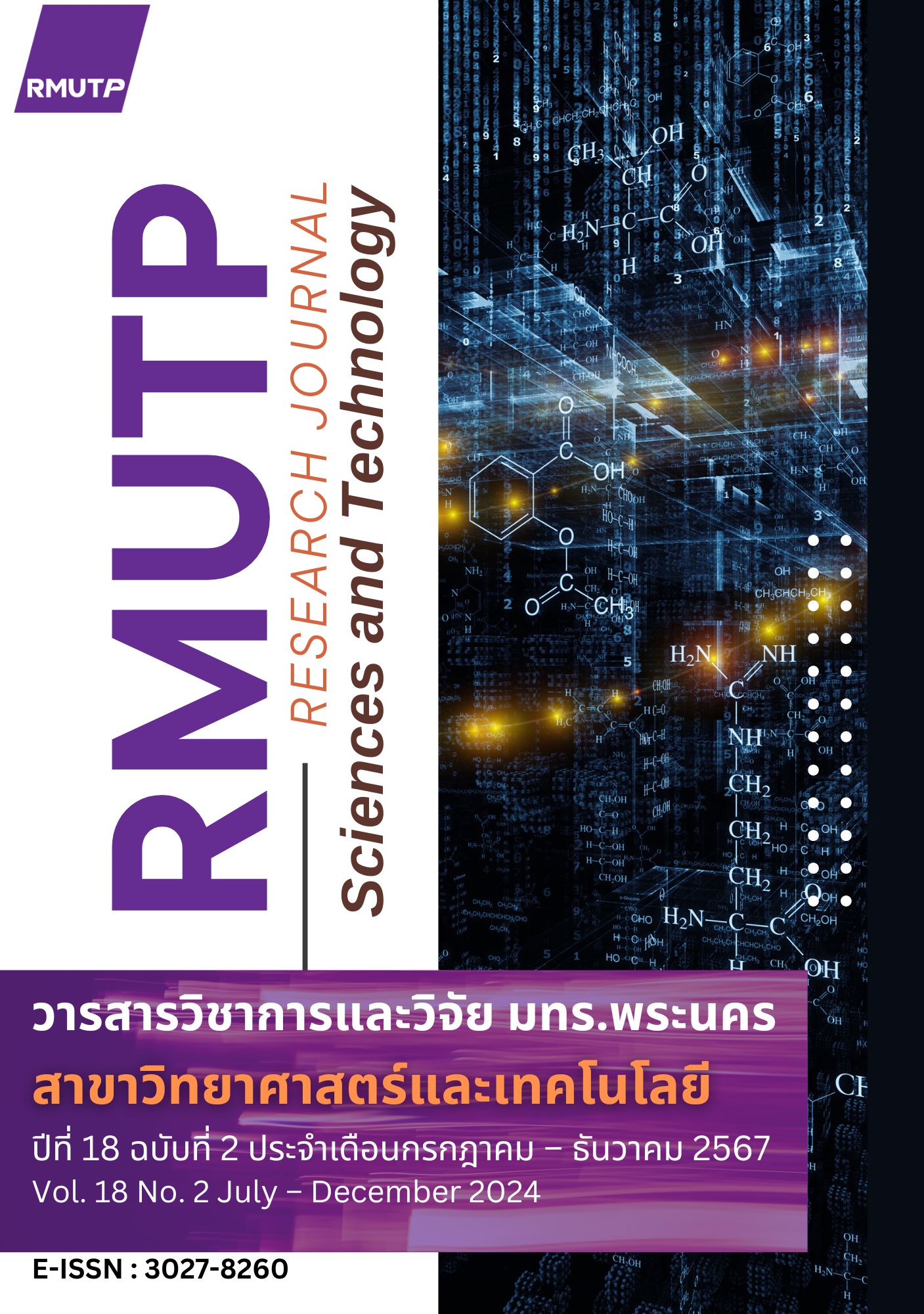Development of Single-use Plate from waste of Sanpatong Seedling
Main Article Content
Abstract
Recently, it has been of great interest involving to mitigate the environmental impact by changing the plant processing waste towards the circular economy concept. This research was aimed to add value to waste from processing of Sanpatong sticky rice seedling. Disposable plate was made from starch foam mixed with waste from processing of Sanpatong sticky rice seedling by compression molding. The content of rice seedling waste was not more than 14 weight percent of starch foam. The compression condition is 170oC with the pressure of 14 MPa. The area, the thickness, and the density of disposable container are 144cm2, 1-2 mm. and 0.20-0.46 g/cm3, respectively. The disposable plate is light and the density does not depend on the content of waste of rice seedling. The flexural strength of disposable plate is about 3.2-3.5 MPa which is lower than that of commercial one. The water adsorption of disposable plate decreased when adding not more than 10wt% of kaolin and latex rubber in starch foam. Coating with polylactic acid on disposable container can also reduce the water adsorption.
Article Details

This work is licensed under a Creative Commons Attribution-NonCommercial-NoDerivatives 4.0 International License.
ลิขสิทธ์ ของมหาวิทยาลัยเทคโนโลยีราชมงคลพระนครReferences
A. Lopez-Gila, F. Silva-Bellucci, D. Velasco, M. Ardanuy, and M. A. Rodriguez-Pereza, “Cellular structure and mechanical properties of starch-based foamed blocks reinforced with natural fibers and produced by microwave heating” Industrial Crops and Products, Vol. 66, pp. 194-205, Mar 2015.
N. H. P. Rodrigues, J. T. Souza, R. L. Rodrigues, M. H. Giovanetti Canteri, S. M. K. Tramontin , and A. C. Francisco, “Starch-based foam packaging developed from a by-product of potato industrialization (Solanum tuberosum L.)” Applied Science, Vol.10, pp.2235-2346, 2020.
T. Manangan and S. Shawaphun, “PHB and PLA coated bagasse paper for biodegradable food packaging” The Journal of King Mongkut's University of Technology North Bangkok, Vol. 20 no. 2, pp. 215-223, 2010.
N. Soykeabkaew, C. Thanomsilp, and O. Suwantong, (2015). “A review: Starch-based composite foams”. Composites: Part A, Vol. 78, pp. 246-243, 2015.
W. Sanhawong, P. Banhalee, A. Boonsang and S. Kaewpirom, “Effect of concentrated natural rubber latex on the properties and degradation behavior of cotton-fiber-reinforced cassava starch biofoam” Industrial Crops and Products, Vol. 108, pp. 756-766, 2017.
F. B. Bergel, L. Machado da Luz, and R. M. C. Santana “Effect of poly(lactic acid) coating on mechanical and physical properties of thermoplastic starch foams from potato starch”, Progress in Organic Coatings, Vol. 118, pp. 91-96, 2018.
M. Jarpa-Parra and L. Chen, “Applications of plant polymer-based solid foams: current trends in the food industry”. Applied Science, Vol.11, 9605, 2021.
J. B. Engel, A. Ambrosi and I. C. Tessaroa, “Development of biodegradable starch-based foams incorporated with grape stalks for food packaging”, Carbohydrate polymers, Vol 225, 115234, 2019.
J. C. Benezet, A. Stanojlovic-Davidovic , A. Bergeret, L Ferry. and A. Crespy, “Mechanical and physical properties of expanded starch, reinforced by natural fibres” Industrial Crops and Products, Vol. 37, pp. 435-440, 2012.
N. Kaisangsri, O. Kerdchoechuen and N. Laohakunjit, “Characterization of cassava starch based foam blended with plant proteins, kraft fiber, and palm oil” Carbohydrate Polymers, Vol. 110, pp. 70-77, 2014.
K. Trongchuen, S. Kethaew, K. Kamwilaisak, P. Kasemsiri and K. Saengprachatanarug, “Characterization of cassava starch foam composite containing spent coffee grounds” KKU Research Journal (graduate study) Vol. 17 no. 1 pp. 81-91, Jan 2017.
P. Cinelli, E. Chiellini, J. W. Lawton and S. H., Imam, “Foamed articles based on potato starch, corn fibers and poly(vinyl alcohol)”. Polymer Degradation and Stability, Vol. 91, pp. 1147-1155, 2006.
K. Kaewtatip, V. Tanrattanakul and W. Phetrat “Preparation and characterization of kaolin/starch foam” Applied Clay Science, Vol. 80-81, pp. 413-416, 2013.
A. E. S. Vercelheze, A. L. M. Oliveira, M. I. Rezende and C. M. O. Muller, F. Yamashita and S. Mali “Physical properties, photo- and bio-degradation of baked foams based on cassava starch, sugarcane bagasse fibers and montmorillonite” Polymers and the Environment, Vol 21, pp. 266-274, 2013.
B. D. Ratner, “Surface modification of polymers: chemical, biological and surface analytical challenges” Biosensors and Bioelectronics, Vol.10, pp. 797–804, 1995.
K. J. L Burg, W. D Holder, C. R Culberson, R. J Beiler, K. G Greene, A. B Loebsack, W. D Roland, D. J Mooney, C. R Halberstadt “Parameters affecting cellular adhesion to polylactide films”. Journal of Biomaterials Science Polymer Edition, Vol. 10, pp.147–161, 1999.
S. Chaireh, P. Ngasatool, and K. Kaewtatip “Novel composite foam made from starch and water hyacinth with beeswax coating for food packaging applications”, International Journal of Biological Macromolecules, Vol 165, Part A, pp. 1382-1391, 2020.

